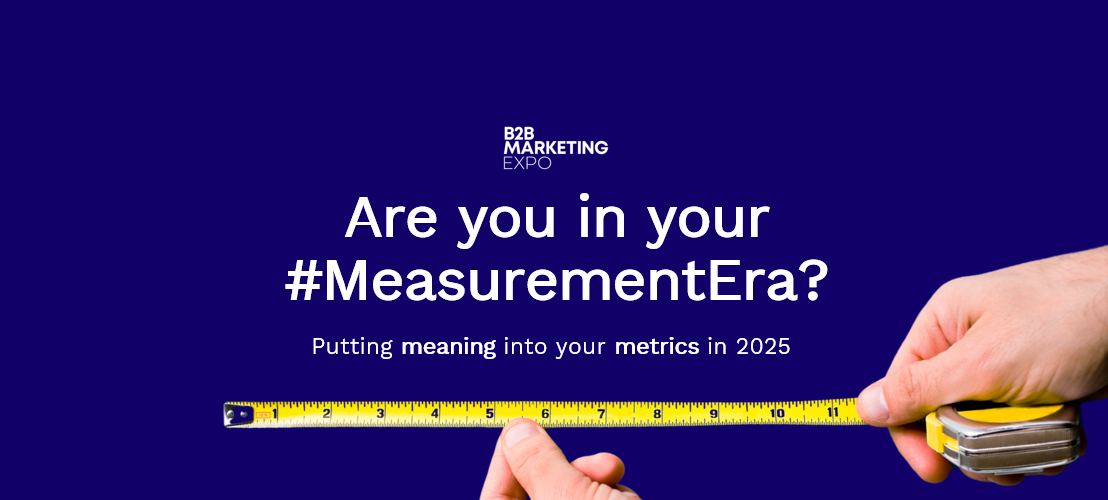Have you ever been asked to demonstrate the value of your marketing budget to leaders within your business? You’re not alone. According to LinkedIn’s B2B Benchmark report, 76% of B2B marketers feel under pressure to prove return-on-investment in the short term while nearly half cite ROI as the most important metric when reporting to the CEO, CFO and other board members.
However, when it comes to collecting insights to help do this, 72% of marketers are struggling to understand and explain the data they have at their fingertips. This is resulting in marketing budgets being put under jeopardy, with business leaders perceiving it as a cost creator rather than a revenue generator.
We know that this perception needs to change! The question is how? In short, we know that data is key but the real magic happens when that data is used as part of your measurement toolkit to show the impact of a marketing campaign. This can be drilled down into a ‘measurement formula’: data + context = impact. It sounds simple, right? Don’t worry, we know it’s not quite that black and white. To help you get started, here is everything you need know to make your measurement a success and to showcase why marketing is a budget worth saving.
Impact – your marketing budget shield
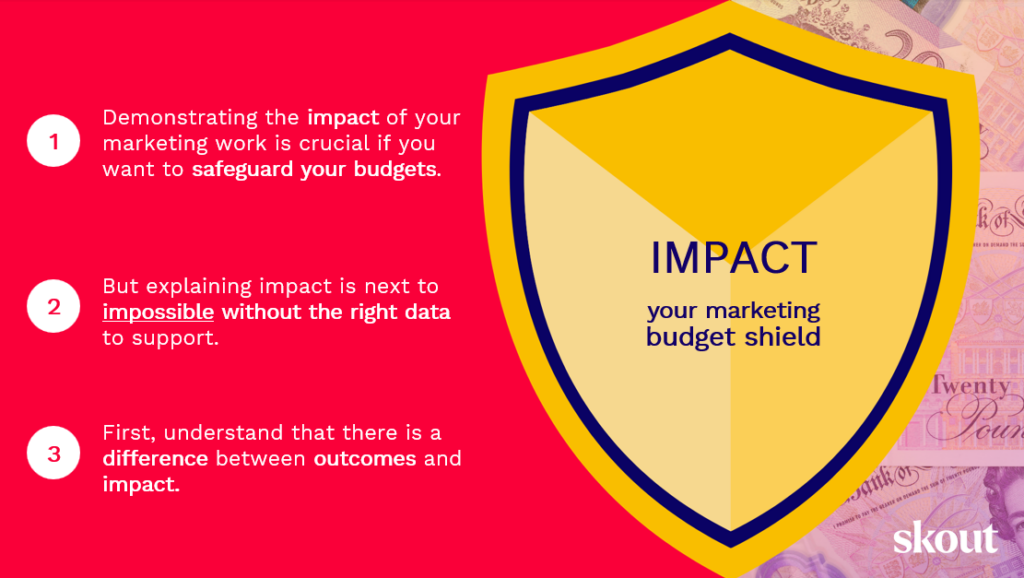
Demonstrating the impact of your marketing campaigns is crucial if you want to safeguard your budget as it shows the board how the activity you’re working on can turn the dial on sales. Understanding impact is therefore an effective weapon to have when challenged, when compiling reports, or when monitoring the success (or failure) of a campaign. If you can demonstrate the impact of your activity within the context of the business, you are much more likely to see your budget grow rather than reduce.
Remember, impact is very different to outcomes. By definition, an outcome is the result of an activity that has been carried out. For example, a piece of content that’s been downloaded 50 times from the website would have an outcome of increased awareness; or, when thinking about our bread and butter, a PR campaign could have an outcome of 30 pieces of coverage. But these are all just numbers which are essentially meaningless without context. By layering outcomes with additional data and narrative you start to edge closer to impact – the demonstration of the market effect or influence your activity has had on the business.
Data – a powerful tool to get a true picture of impact
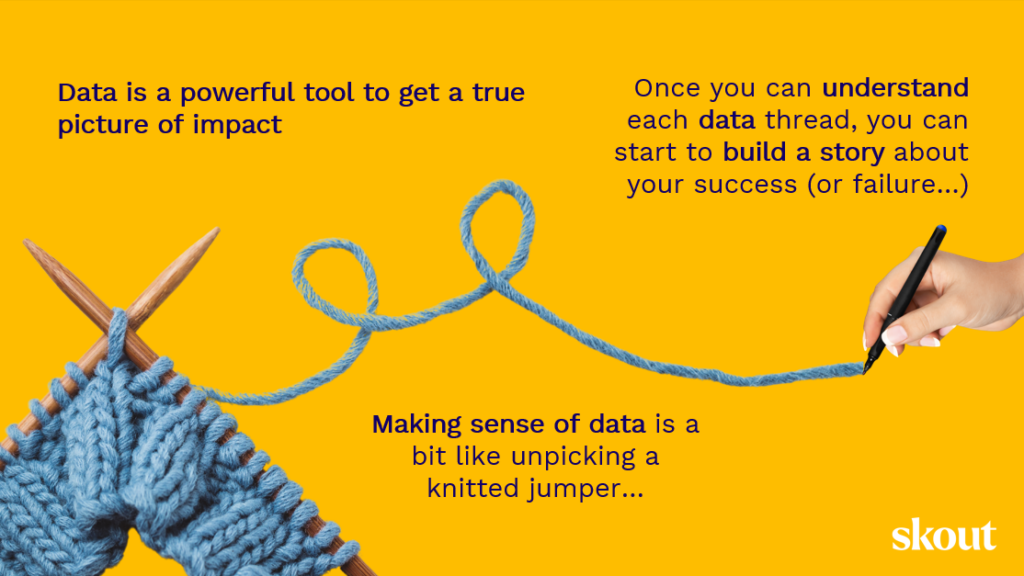
Love it or hate it, data is a very powerful tool. If you are not living in the numbers, for at least some of your working week, then you are not getting the true picture of the impact your work is having. Data can show you how a prospect finds you, interacts with you and travels through the sales funnel to become a customers. It can show you how a campaign has resonated with an audience, how your website is performing, what engagement your content is having etc. In today’s marketing environment, nearly all activity has data that sits behind it. The trick is to unpick that data and then, try to understand it. I like to compare this to unpicking a knitted jumper to see how it was all put together or taking apart a car engine to understand how it works. Once you’ve done this, you can gain useful insights that well help to drive future decisions.
To elevate this further, it is even more important to be able to interpret what the data is telling you, so you can quickly explain to others why and how your marketing has delivered value. This is what impact really is. It’s the story the data is telling you about the success or failure of your campaigns – and there is real skill in being able to tell that story. Otherwise, it’s like seeing text in a foreign language; you know all of the letters but can’t translate it.
Effective measurement lies in the interpretation of the story
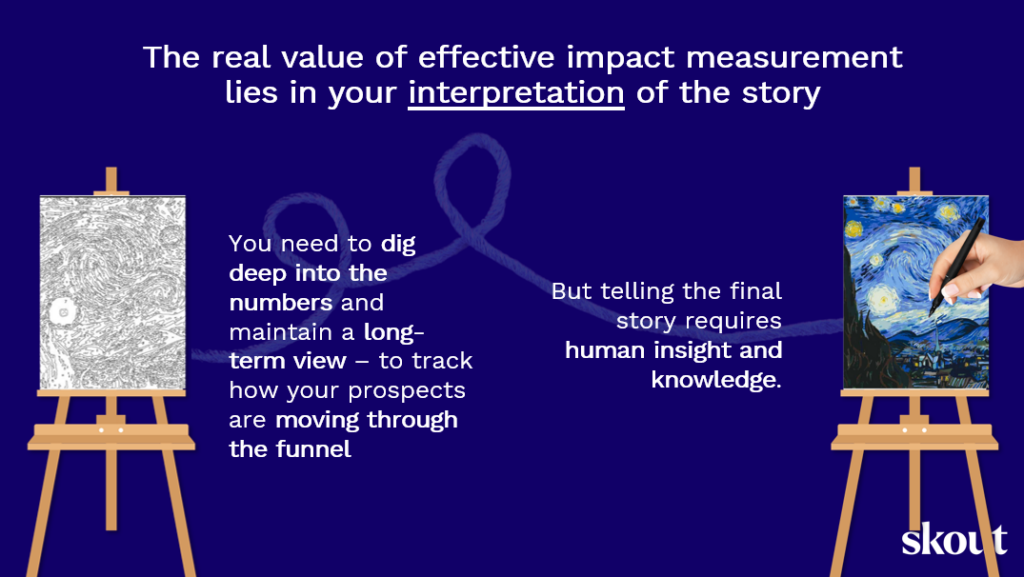
You can have all of the data points in the world but if you have no idea what picture they are painting, they are simply numbers on a screen. Think of it this way; data essentially is just a summary of a thousand stories. Stories are incredibly powerful so by telling just a few of them, you can make the data meaningful, bringing it to life and demonstrating the value. In a nutshell, the real value in effective impact measurement is in the interpretation of the data – its story.
For example: A piece of coverage lands in a highly respected publication. It receives hundreds of online views, good engagement rates and a high number of click throughs to your website. That’s great – it’s an outcome that you really wanted for this story. But what does it all mean? To understand the impact of this you need to dig into the numbers – and lots of them. You’ll need to look at website traffic spikes, content downloads, increases in social media followers to name but a few. But then you also need a longer-term view of what happens to these people over time – do they continue to engage, how far down the funnel do they get, have they become an MQL? To track the real impact of a single piece of coverage will require multiple data points over time.
The same is true of any type of marketing activity: from newsletters to gated content, advertising campaigns to paid social media. It’s all measurable with the right data to hand and you can tell the full story of what it is achieving for your business. You can show how your social media activity is linked to your gated content which results in the acquisition of prospects. You can then track these prospects through your CRM system to show the other touchpoints that they are exposed to until they become a physical customer of the business. You are telling the story of customer acquisition through marketing activity by making the data work for you.
Like I’ve previously mentioned, telling the story is a skill – one that requires human knowledge and insight. It takes time and thought to be able to interpret the data. For example, being able to see how a prospect travels through your sales funnel means you need to look at the data from awareness activities, through consideration and into intent, tracking their engagement with your marketing activity at every step. This may start off as just big numbers – tens of thousands of web visits down to hundreds of content downloads and into tens of lead forms filled in. The data will show you what is happening, but you need to be able to tell that story.
Failure is feedback – don’t try to hide it!
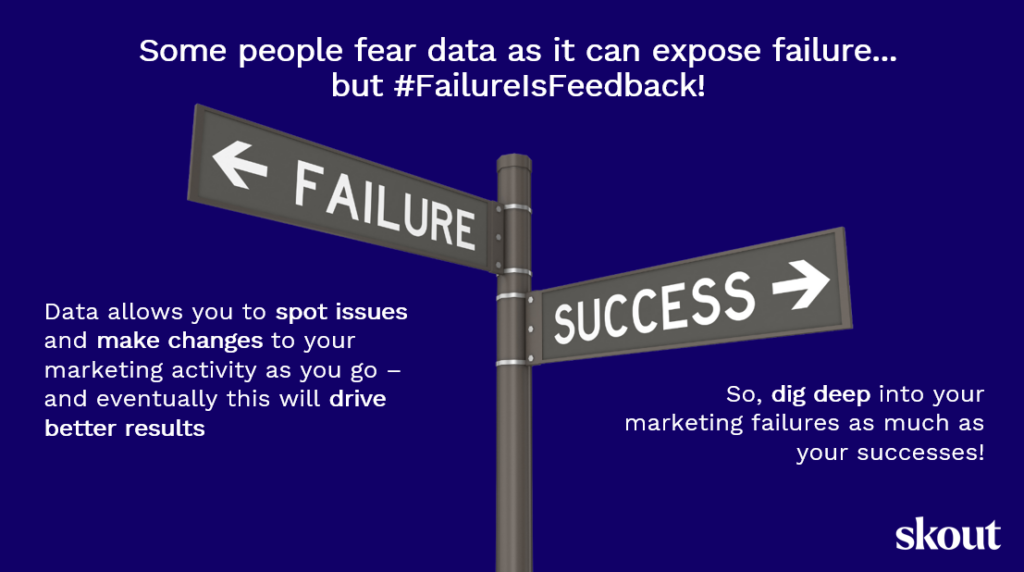
Some marketers are fearful of data as it can expose failures. The great Winston Churchill said that “Success is stumbling from failure to failure with no loss of enthusiasm.” If you put this in the context of marketing, then you have to assume that some of your campaigns will fail. They will fail to land with the right audience, they will fail to deliver the right message at the right time, and they will fail to deliver the impact that you were hoping for. But failure can be viewed in a different way – it is your audience telling you that your campaign wasn’t quite right. Like telling a bad joke and nobody laughing. Data is the key for effective feedback – short of talking to every prospect and listening to their story, it’s the best way to gather actionable insights. Failure is simply feedback.
Having one eye on the data allows you to make changes to your marketing activity in real time, taking on board the feedback and tweaking your campaigns until they start to have a positive result. Without the data you are running blind. Ask yourself this – do you dig into your failures as deeply as you dig into your successes? There is just as much knowledge and insight to be gained from the things that don’t work from the things that do.
Predicting the future

Data insights can do more than just give you a historical view. They can also help you to paint a picture of the future. By accessing the data and understanding the story that it is telling you, you can predict the responses that your marketing will receive. You will also be better equipped to know what message works with which audience, what type of content delivers the best results, when the best time of day is to target your prospects and also which type of activity drives intent. Using this information, you enable you to plan campaigns much more effectively, targeting each part of the sales funnel – from awareness, through consideration to intent – with the result being an increase in MQL’s for the business and the possibility of increased sales (providing your sales teams are aligned to pick up the MQLs and carry out meaningful conversations).
Don’t take a shot in the dark. You have data – use it!
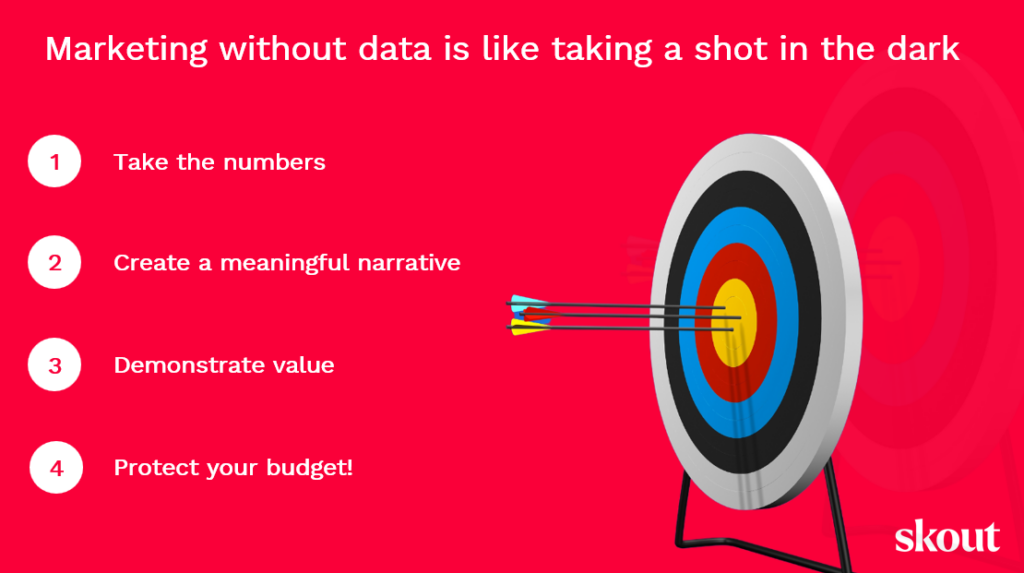
Planning your marketing activity without the data to support this is like taking a shot in the dark – you are just guessing at what will have the biggest impact on the bottom line. I would encourage you to make friends with Google Analytics, Salesforce, LinkedIn analytics, CRM systems and any other platforms that your business uses so that you can create your own masterpiece with the numbers these provide you with. In an age where AI is growing exponentially, it’s only a matter of time before a system is developed that makes this an automated job but for now, the AI exists within your own brain. Taking the numbers to create a meaningful narrative – the real impact and value of what you are doing – allows you to celebrate the successes and understand the failures of your campaigns. This is crucial to demonstrating the value of marketing to your business and ultimately to protecting your budgets.
Struggling to demonstrate the value of your B2B PR investment to C-Suite? Download our ‘Demystifying Measurement’ report, to find out how you can better communicate the ROI of PR activity.
